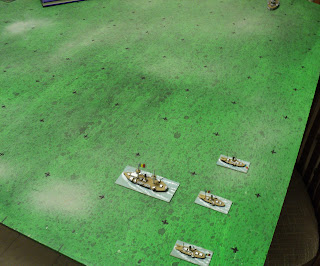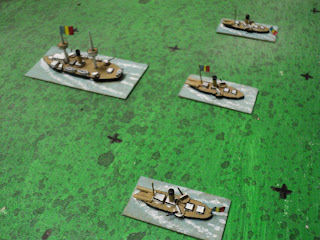Tuesday, 22 June 1875, about 40 kilometres off Poti coast. Course due south, cruising speed 10 knots, in company with TB flotilla, 3 vessels. Weather clear, light winds from NW, barometer high, but falling.
7 Bells of the Morning Watch, sighted smoke due west of our position. Altered course eight points to starboard to investigate. Sighting proved to be TNS Hamidiye, protected cruiser. Kapitan-Leytenant Aleksandr Markovitch Ramius ordered the attack, increasing speed to 18 knots. Czarina Elizaveta at the larboard end of the line, the TBs to starboard, echeloned forward.
1 Bell of Forenoon Watch: Hamidiye alters course to due south, then after a short interval, resumes its easterly course to close the range on Czarina Elizaveta.
2 Bells of the Forenoon Watch: Range closing. Enemy vessel fires his first salvo...
 |
| First sighting... |
The Ships:
 |
| Protected cruiser Hamidiye. |
Turcowaz:
Hamidiye, protected cruiser: 10FP, Range/Dice - 4/5D6; Move 3.
 |
| Izumrud-Zeleniya flotilla, led by Tsarina Elizaveta. |
Izumrud-Zeleniya:
Czarina Elizaveta, light cruiser: 8 Flotation Points (FP); Range/Dice - 3/4D6; Move - 3 squares.
TB1, Smeul, torpedo boat: 4FP; Range/Dice - 2/3D6; Move 4; 2 Torpedoes fixed bow.
TB2, Naluca, torpedo boat: 4FP; Range/Dice - 2/3D6; Move 4; 2 Torpedoes fixed bow.
TB3, Sborul, torpedo boat: 4FP; Range/Dice - 2/3D6; Move 4; 2 Torpedoes fixed bow.
 |
| Izumrud-Zeleniya form a concave 'cordon'. |
 |
| Adversaries on opposite courses... |
 |
| 'Ramming speed!' |
 |
| After ramming, Hamidiye fires into Tsarina Elizaveta |
Perhaps this was occasioned by the incoming fire from the nearest torpedo boat, TB3 - Sborul, which, the course having been altered to the south, had been placed in the lead of the line echeloned back from the larboard end. Her first salvo, at maximum range, not only found its target, but managed to put its shells where they could do maximum damage. At once Hamidiye was in real trouble.
Up until this point, Hamidiye had taken a hit from Czarina Elizaveta and lost a further flotation point (FP), self inflicted, from the ramming. Reduced to 2 FPs, Czarina Elizaveta was forced to stagger out of the battle. But now Sborul, firing with 2 dice at extreme range (2 squares) rolled two sixes! Four FPs at one blow! Hamidiye's return fire did some damage, but not enough.
As Hamidiye ploughed onward, TB3-Sborul came in under her stern whilst TB2-Naluca came in from abeam. TB1-Smeul was not yet quite where she could release its torpedo. Pressing in close, under a welter of incoming gunfire, the TBs soon launched a torpedo each. The torpedoes away, it was time, perhaps, to depart... if they could.
 |
| Czarina Elizaveta limps off, covered by TB attacks |
Too late. At short range, Hamidiye's gunfire was deadly and lethal. TB2 and TB3, already both somewhat damaged, were last seen entering a maelstrom of exploding shells and water spouts. Neither emerged.
What of the torpedoes, then? They were on their way, the range was short, nothing could stop them. That from TB3-Sborul struck under Hamidiye's stern, where it caused enough damage to have persuaded the cruiser to abandon the fight (3D6s yielded 1 point of damage). The fatal blow came from TB2-Naluca. The torpedo struck amidships, tore out a huge hole and tore into Hamidiye's vitals. Three D6s yielded a 5 (-1 FP) and a 6! (-2FP). That was it. Although it took long enough for the few survivors to be got off, Hamidiye at last slid beneath the waves to join the vessels she had killed and was killed by.
 |
| TNS Hamidiye's last moments... |
You could call it a victory - and Izumrud-Zeleniya's Press Services certainly did - but it was a costly one. Two torpedo boats sunk, and Czarina Elizaveta out of commission for months to come. But TNS Hamidiye had been the pride and joy of the Turcowaz navy - not for her size, but for the quality of its crew.
Some post-action comment.
There were a number of ways I could have played this. For one thing, this is the first action I played out on a square grid table instead of my hex grid. The other is that, contrary to my usual practice, I used Bob's technical stats instead of my own. To be sure, the Izumrud-Zeleniyan flotilla had a considerable measure of luck in this action - especially the 4FPs of damage right off TB3's first salvo of gunfire. That at once compromised Hamidiye's chances of survival.Now, I haven't done any technical stats for the Izunrud-Zeleniya's vessels (actually 'Romanian'). But I rather think they would have been considerably less powerful than they were in this action. Looking up the 'historical' versions of these vessels, I find that Hamidiye was rather faster at top speed than any of it's opponents. The Turcowaz ship might well have been able to stand off out of their range, and shoot them to pieces. Methinks it would have gone hard for Izumrud-Zeleniya, had I chosen to use 'my' alternate stats and Hamidiye had found the convoy - especially had the troops still been aboard...
Aftermath.
The loss of Hamidiye put paid to Turcowaz naval operations in support of the Kavkaz campaign. But their enemy hoped that something might yet be achieved with what remained of their flotilla. There was no question about Czarina Elizaveta's having to return to Sebastopol; the damage enough to compromise her seaworthiness. There remained, then, one merchant cruiser, Yevgeni Onegin, and one torpedo boat.Not a lot to work with...
To be continued: Third Zugdidi.




















































